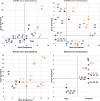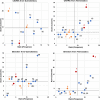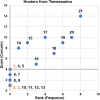A participatory epidemiological and One Health approach to explore the community's capacity to detect emerging zoonoses and surveillance network opportunities in the forest region of Guinea
- PMID: 35816491
- PMCID: PMC9273079
- DOI: 10.1371/journal.pntd.0010462
A participatory epidemiological and One Health approach to explore the community's capacity to detect emerging zoonoses and surveillance network opportunities in the forest region of Guinea
Abstract
The Ebola virus disease epidemic that threatened West Africa between 2013 and 2016 was of unprecedented health magnitude. After this health crisis, studies highlighted the need to introduce community-based surveillance systems and to adopt a One Health approach. This study aimed to provide preparatory insights for the definition of a community-based surveillance system for emerging zoonoses such as viral hemorrhagic fevers in Guinea. The objective was to explore the disease detection capacity and the surveillance network opportunities at the community level in two pilot areas in the forest region of Guinea, where the epidemic emerged. Based on a participatory epidemiological and One Health approach, we conducted Focus Group Discussions with human, animal and ecosystem health actors. We used a range of participatory tools, included semi-structured interviews, ranking, scoring and flow diagram, to estimate the local knowledge and perception of diseases and clinical signs and to investigate the existing health information exchange network and its related strengths and weaknesses. The results showed that there is heterogeneity in knowledge of diseases and perception of the clinical signs among actors and that there are preferred and more effective health communication channels opportunities. This preparatory study suggests that it is necessary to adapt the case definitions and the health communication channels to the different actors who can play a role in a future community-based surveillance system and provides recommendations for future surveillance activities to be carried out in West Africa.
Conflict of interest statement
The authors have declared that no competing interests exist.
Figures





Similar articles
-
Sending the Right Message: Wild Game and the West Africa Ebola Outbreak.Health Secur. 2018 Jan/Feb;16(1):48-57. doi: 10.1089/hs.2017.0086. Health Secur. 2018. PMID: 29451827
-
Sensitivity and Specificity of Suspected Case Definition Used during West Africa Ebola Epidemic.Emerg Infect Dis. 2018 Jan;24(1):9-14. doi: 10.3201/eid2401.161678. Emerg Infect Dis. 2018. PMID: 29260687 Free PMC article.
-
Ebola Surveillance - Guinea, Liberia, and Sierra Leone.MMWR Suppl. 2016 Jul 8;65(3):35-43. doi: 10.15585/mmwr.su6503a6. MMWR Suppl. 2016. PMID: 27389614
-
The West African ebola virus disease epidemic 2014-2015: A commissioned review.Niger Postgrad Med J. 2016 Apr-Jun;23(2):49-56. doi: 10.4103/1117-1936.186299. Niger Postgrad Med J. 2016. PMID: 27424613 Review.
-
Ebola: Anatomy of an Epidemic.Annu Rev Med. 2017 Jan 14;68:359-370. doi: 10.1146/annurev-med-052915-015604. Epub 2016 Oct 21. Annu Rev Med. 2017. PMID: 27813879 Review.
Cited by
-
Co-designing zoonotic diseases prevention practices when people depend on wild meat.One Health. 2025 May 13;20:101074. doi: 10.1016/j.onehlt.2025.101074. eCollection 2025 Jun. One Health. 2025. PMID: 40503453 Free PMC article.
-
Data Parameters From Participatory Surveillance Systems in Human, Animal, and Environmental Health From Around the Globe: Descriptive Analysis.JMIR Public Health Surveill. 2025 Mar 26;11:e55356. doi: 10.2196/55356. JMIR Public Health Surveill. 2025. PMID: 40138683 Free PMC article.
-
An experimental game to assess hunter's participation in zoonotic diseases surveillance.BMC Public Health. 2024 Feb 1;24(1):342. doi: 10.1186/s12889-024-17696-7. BMC Public Health. 2024. PMID: 38302879 Free PMC article.
-
Participatory Disease Surveillance for the Early Detection of Cholera-Like Diarrheal Disease Outbreaks in Rural Villages in Malawi: Prospective Cohort Study.JMIR Public Health Surveill. 2024 Jul 16;10:e49539. doi: 10.2196/49539. JMIR Public Health Surveill. 2024. PMID: 39012690 Free PMC article.
-
Gaps and opportunities for data systems and economics to support priority setting for climate-sensitive infectious diseases in sub-Saharan Africa: A rapid scoping review.PLOS Glob Public Health. 2025 Jun 11;5(6):e0003814. doi: 10.1371/journal.pgph.0003814. eCollection 2025. PLOS Glob Public Health. 2025. PMID: 40498692 Free PMC article.
References
Publication types
MeSH terms
LinkOut - more resources
Full Text Sources
Medical

